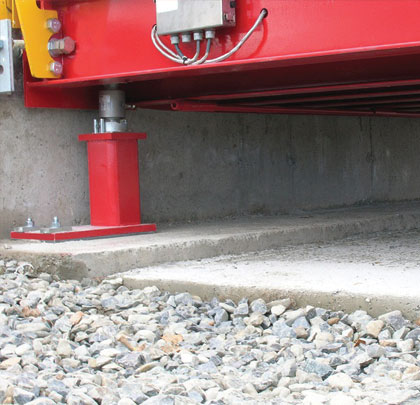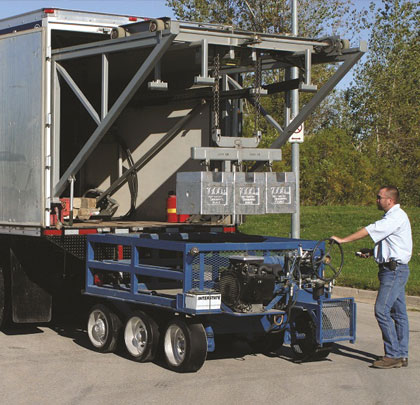Truck Scales Owners’ Best Practices in the Recycling and Solid Waste Industry
In today’s recycling and solid waste industry, uptime is of utmost importance. Most facilities experience long lines at the scale, and so they place a premium on getting trucks in and out quickly. However, have you ever stopped to think about how much you could be losing per truck?

When you placed your scale in service, the state Weights & Measures Department certified that it met the necessary regulatory requirements, and your manufacturer assured you that the scale was capable of holding to accurate tolerances. Unfortunately, external variables and real-world issues can knock your scale out of calibration and cost you a lot of money. To maximize uptime, implement the following best practices.
- IMPLEMENT A CALIBRATION & INSPECTION AGREEMENT
The simplest step you can take is to implement a calibration and inspection agreement with your service provider. Depending on the requirements and type of weighing device, inspection costs can be as low as $500 annually, depending on the frequency required to assure accurate weighing and to reduce the risk of loss due to an inaccurate scale.Fairbanks Scales, a leading provider of top quality industrial weighing equipment and service, recommends a minimum of two inspections per year for most scales, but the sort of heavy traffic which recycling and solid waste facilities experience can easily justify more frequent verification, inspection, and service. Consult with your scale service company about a schedule that works best for your company. - KEEP THE SCALE FOUNDATION CLEAN
Recycling and solid waste operations can generate a lot of debris. Be sure to regularly remove the buildup to avoid scale inaccuracies. A pressure sprayer is a fast and easy way to clear debris and keep the scale and foundation free of buildup. Be sure that your junction boxes, electronics, and load cells are properly rated to withstand pressure washing to avoid damage. - PERFORM YOUR OWN INSPECTION
Inspect for anomalies. A properly operating scale is dependent on every component working together. Inspect the weighbridge for damage or signs of wear and corrosion. - MAKE ADJUSTMENTS
Your weighbridge will expand and contract slightly at different times of the year; this is natural. This thermal expansion requires attention and readjustment of your checking. The checking system on your scale keeps the weighbridge in place as it naturally rocks and moves from traffic. Too small a gap in the checking can cause binding and weighing errors. Too much gap in the checking allows excessive movement, up to and including a scale tipping. Excessive movement adds unnecessary wear to other components, so be sure the checking is properly secure. - KEEP YOUR SCALE GROUNDED
Today’s truck scales use sophisticated electronics to communicate weighment data to the instrument. A securely grounded scale is a basic defense from lightning and power surges. Be sure that the scale is connected to the manufacturer’s specified grounding system and that there are no interruptions in this system. - MONITOR YOUR SCALE’S USE
You probably don’t have the time to monitor how fast traffic enters and exits the scale. However, keep in mind that while the scale is designed to slightly move with traffic, abusive and aggressive entrance and exiting of traffic accelerates wear. Again, taxing the scale means more wear and more dollars spent in repairs. - INSTALL ACCESSORIES WHERE NECESSARY
Many scale manufacturers offer accessories to promote traffic discipline while entering and exiting your scale. Traffic signals and guide post kits at the approach and exit can manage traffic flow and truck speed very effectively for a small investment. Consider the accessories below, developed from real-world experience, to prevent issues with your truck scale altogether.Riser plates: Riser plates elevate your weighbridge, reducing the risk of debris accumulation and providing clearance for cleaning and inspection.Load cell boots: Exposed to debris, weather, moisture, and even product that has migrated below the deck, your load cells operate in the worst environment possible. Load cell boots act like a protective glove and prevent debris from interfering with proper load cell operation.Steel and EPDM rubber belting: At each end of your scale, there is a small gap between the scale and foundation. This gap is a great place for dirt, debris, and product to fall under the scale and accumulate. Installing T-belting along this gap between the scale and foundation wall is a good step to preventing this accumulation.
In the end, how you implement these best practices is up to you. You can partner with a qualified service provider to manage these tasks, or you can go it alone. One thing is certain—neglecting your scale costs you profit. ■
For More Information:
For more information about the Fairbanks Scales products, call 800.451.4107, or visit www.fairbanks.com.
_________________________________________________________________________
Modern Contractor Solutions, April 2013
Did you enjoy this article?
Subscribe to the FREE Digital Edition of Modern Contractor Solutions magazine.



